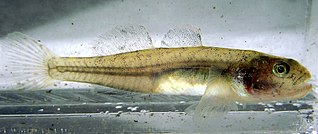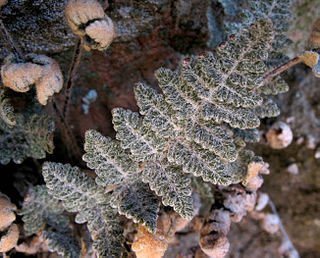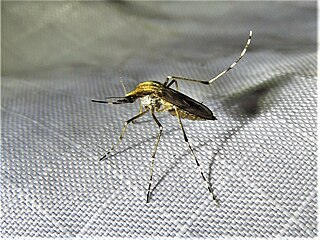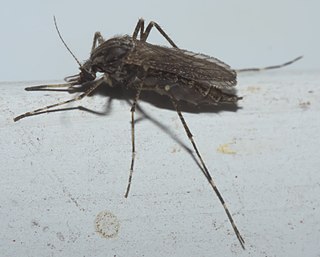
Branchiopoda is a class of crustaceans. It comprises fairy shrimp, clam shrimp, Diplostraca, Notostraca, the Devonian Lepidocaris and possibly the Cambrian Rehbachiella. They are mostly small, freshwater animals that feed on plankton and detritus.

The sterile insect technique (SIT) is a method of biological insect control, whereby overwhelming numbers of sterile insects are released into the wild. The released insects are preferably male, as this is more cost-effective and the females may in some situations cause damage by laying eggs in the crop, or, in the case of mosquitoes, taking blood from humans. The sterile males compete with fertile males to mate with the females. Females that mate with a sterile male produce no offspring, thus reducing the next generation's population. Sterile insects are not self-replicating and, therefore, cannot become established in the environment. Repeated release of sterile males over low population densities can further reduce and in cases of isolation eliminate pest populations, although cost-effective control with dense target populations is subjected to population suppression prior to the release of the sterile males.

The order Notostraca, containing the single family Triopsidae, is a group of crustaceans known as tadpole shrimp or shield shrimp. The two genera, Triops and Lepidurus, are considered living fossils, with similar forms having existed since the end of the Devonian, around 360 million years ago. They have a broad, flat carapace, which conceals the head and bears a single pair of compound eyes. The abdomen is long, appears to be segmented and bears numerous pairs of flattened legs. The telson is flanked by a pair of long, thin caudal rami. Phenotypic plasticity within taxa makes species-level identification difficult, and is further compounded by variation in the mode of reproduction. Notostracans are omnivores living on the bottom of temporary pools and shallow lakes.

Triops is a genus of small crustaceans in the order Notostraca. The long-lasting resting eggs of several species of Triops are commonly sold in kits as pets. The animals hatch upon contact with fresh water. Most adult-stage Triops have a life expectancy of up to 90 days and can tolerate a pH range of 6 to 10. In nature, they often inhabit temporary pools.

Hesperoyucca whipplei, the chaparral yucca, our Lord's candle, Spanish bayonet, Quixote yucca or foothill yucca, is a species of flowering plant closely related to, and formerly usually included in, the genus Yucca. It is native to southwest communities of North America.

Mosquito control manages the population of mosquitoes to reduce their damage to human health, economies, and enjoyment. Mosquito control is a vital public-health practice throughout the world and especially in the tropics because mosquitoes spread many diseases, such as malaria and the Zika virus.

Hesperoyucca is a small genus of two recognized species of flowering plants closely related to, and recently split from, Yucca, which is in the century plant subfamily within the asparagus family.

Eucyclogobius newberryi, the northern tidewater goby, is a species of goby native to lagoons of streams, marshes, and creeks along the coast of California, United States. The northern tidewater goby is one of six native goby species of California. It is protected under the Endangered Species Act as an endangered species of the United States since 1994.

Myxoma virus is a poxvirus in the genus Leporipoxvirus. The two broad geographic types of myxoma virus are Californian and South American. Californian myxoma virus is found on the West Coast of the United States, the Baja Peninsula of Mexico, and the southwest coast of Canada. South American or Brazilian myxoma virus is found in South and Central America. South American myxoma virus circulates in the jungle rabbit or tapeti, whereas Californian myxoma virus circulates in the brush rabbit. In their native hosts, the viruses cause the formation of benign cutaneous fibromas rather than systemic disease.

Oligoryzomys is a genus of rodents in the tribe Oryzomyini of family Cricetidae. Many species are known as pygmy rice rats or colilargos. The genus is found from Mexico to Tierra del Fuego and includes approximately 17 species.

Triops longicaudatus is a freshwater crustacean of the order Notostraca, resembling a miniature horseshoe crab. It is characterized by an elongated, segmented body, a flattened shield-like brownish carapace covering two thirds of the thorax, and two long filaments on the abdomen. The genus name Triops comes from Greek ὤψ or ṓps, meaning "eye" prefixed with Latin tri-, "three", in reference to its three eyes. Longicaudatus is an Latin neologism combining longus ("long") and caudatus ("tailed"), referring to its long tail structures. Triops longicaudatus is found in fresh water ponds and pools, often in places where few higher forms of life can exist.

The Gobiiformes are an order of fish that includes the gobies and their relatives. The order, which was previously considered a suborder of Perciformes, is made up of about 2,211 species that are divided between seven families. Phylogenetic relationships of the Gobiiformes have been elucidated using molecular data. Gobiiforms are primarily small species that live in marine water, but roughly 10% of these species inhabit fresh water. This order is composed chiefly of benthic or burrowing species; like many other benthic fishes, most gobiiforms do not have a gas bladder or any other means of controlling their buoyancy in water, so they must spend most of their time on or near the bottom. Gobiiformes means "goby-like".

Diplurus is a genus of prehistoric mawsoniid coelacanth fish which lived during the Late Triassic-Early Jurassic period in North America. The fossils of this genus are common on the eastern North American Margin, being a key taxon of the Newark Supergroup, and recovered from units such as the Bull Run Formation, Lockatong Formation, Stockton Formation, Solite Quarry, Midland Formation, East Berlin Formation, Boonton Formation and the Portland Formation. Three species are know, the type D. longicaudatus, the youngest and biggest, D. newarki, the oldest, followed then by "D. uddeni" (Eastman), also from older rocks and considered dubious. A recent work has recovered a 3rd or 4th species, D. enigmaticus, from the Late Triassic of New Jersey, representing another small-bodied form living in sympatry with the similarly sized D. newarki. This genus ranges in size from 15 cm of D. newarki and D. enigmaticus in New Jersey to the larger 60 cm specimens of Diplurus longicaudatus found in the Connecticut River Valley, which indicates a considerable growth and likely a change in the ecological position of the genus to a possible apex predatory niche.

Triops cancriformis, European tadpole shrimp or tadpole shrimp is a species of tadpole shrimp found in Europe to the Middle East and India.

Myriopteris newberryi, formerly Cheilanthes newberryi, is a species of lip fern known by the common name Newberry's lip fern. It is native to southern California and Baja California.

Lepidurus apus, commonly known as a tadpole shrimp, is a notostracan in the family Triopsidae, one of a lineage of shrimp-like crustaceans that have had a similar form since the Triassic period and are considered living fossils. This species is cosmopolitan, inhabiting temporary freshwater ponds over much of the world, and the most widespread of the tadpole shrimps. Like other notostracans, L. apus has a broad carapace, long segmented abdomen, and large numbers of paddle-like legs. It reproduces by a mixture of sexual reproduction and self-fertilisation of females.

Aedes mitchellae mosquitoes were originally collected in southern Georgia and Florida in 1905 by entomologist Harrison Gray Dyar, Jr. The species' range extends through the coastal plains from the southeastern United States, north to New York and west to New Mexico with the greatest abundance in the Atlantic and Gulf coastal plains.

Psorophora columbiae, known generally as the dark ricefield mosquito or glades mosquito, is a species of mosquito in the family Culicidae. They can be found in North America, primarily in the southern United States, such as Arkansas, Louisiana, and Texas.
Triops mauritanicus is a species of tadpole shrimp, found in Southern Spain and Morocco. This species of Triops can grow to 4 to 6 cm and can be expected to live for 90-120 days on average. This species can be usually found in arid areas and are sometimes sold in kits.


















